1.3 Fungi in natural ecosystems
Fungi help the balance of nature by nutrient recycling. Fungi decompose things. Importantly, fungi are about the only organisms that can digest wood, because the lignin which is complexed with the cellulose in wood is so difficult to degrade. Lignin digestion is a fungal speciality but they gain nutrition from living or dead animals as well as plants, and the breakdown of other complex molecules such as cellulose and tannins in soils is due mostly to fungal enzymatic activity.
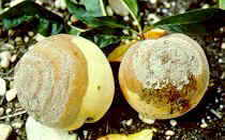 |
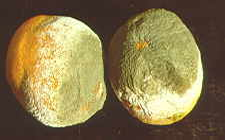 |
| Mouldy apples | Mouldy oranges |
| Images from The Fifth Kingdom by Bryce Kendrick, Mycologue Publications | |
Fungi are all around us, and there are enormous numbers and quantities of them. It's been estimated that fungi make up 90% of the total living BIOMASS in forest soils. For grassland soils, another estimate puts the total length of hyphae at over 1 kilometre per gram weight!
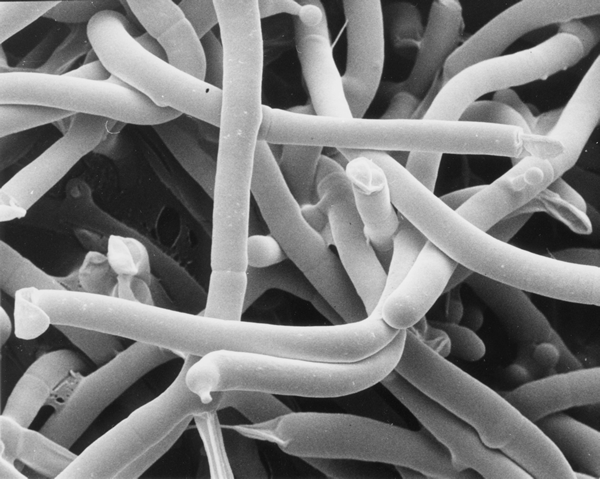 |
| Scanning electron micrograph of hyphae of Pleurotus. Photograph by Dr Carmen Sanchez. |
There is such a large amount of fungal mycelium in most soils that it makes a major contribution to FOOD WEBS by being eaten by numerous vertebrates and invertebrates including insects, mites, molluscs and nematodes. Microarthropods are responsible for shredding organic matter in soil (and so prepare it for the final mineralization processes carried out by microbes), but about 80% of the tens of thousands of microarthropod species in forest soils are fungivores - they depend on the fungal mycelium for food.
When the mycelium makes fruit bodies (like mushrooms, brackets and truffles), these are also vital food sources for many animals, from mammals (including humans) to molluscs, as the following sequence of a slugfest shows ...
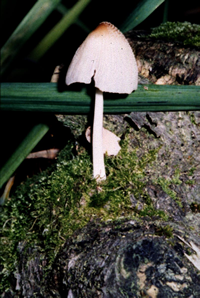 |
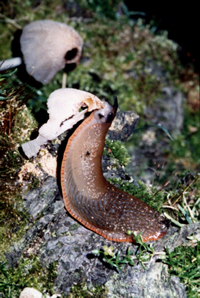 |
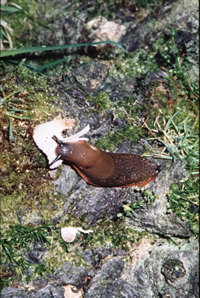 |
| An orange form of the large black slug, Arion ater, completely demolishing a Coprinellus micaceus mushroom fruit body in a garden in south Manchester. All photographs © David Moore 2011 | ||
Because most small mammals depend on hypogeous fruit bodies (especially truffles) for a significant part of their diets the influence of fungi on the food web extends even further. Even top predators, like birds of prey, depend ultimately on the fungi because their prey do so.
Fungal mycelia act as sinks of organic carbon and nitrogen nutrients in the soil.
In many forests, a lot of carbon fixed by photosynthesis ends up in fungal mycelium because of the mycorrhizal symbiotic association in which the fungus assists the growth of forest trees. What is important is that the mycelial sink keeps the nutrients on site preventing loss of nutrient from the soil by leaching.
To survive, most plant species established a symbiotic partnership with a unique group of soil organisms called mycorrhizal fungi. These fungi must be considered to be the biological cornerstone of terrestrial plant life on earth.
This picture shows the mycorrhizal network of the roots of a small pine seedling. Most of the white filamentous growth you can see beneath the soil surface is the mycelium (some aggregated into strands) of the seedling's mycorrhiza. http://www.planthealthcare.co.uk/fungi.html |
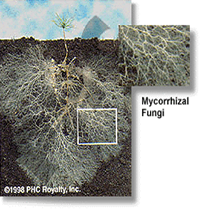 |
These poppies were planted at the same time, in identical commercial potting soil, and exposed to identical amounts of water, sunlight, etc. The pot on the right was inoculated with a commercial mycorrhizal preparation, the one on the left was not. http://www.fungi.com/index.html |
 |
Mycorrhizal colonisation protects plants against diseases, in this case infestation with the cereal pathogen Cochliobolus sativus: right with mycorrhizas, left without. http://www.gmo-safety.eu/science-live/439.mycorrhizas-successful-symbiosis.html |
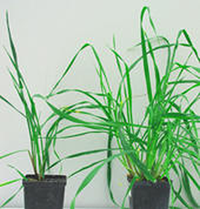 |
The benefits of mycorrhizas to plants include efficient nutrient uptake, especially phosphorus; enhanced resistance to drought stress; and direct or indirect protection against some pathogens. Mycorrhizal fungi also link plants together into communities that are more resilient to stress and disturbance than single plants. When plants are connected by a common fungus, the products of photosynthesis can move through the fungus from a well-placed donor plant to a shaded recipient plant. In nutrient-poor soils, mycorrhizal fungi can provide nitrogen to their host plant that their mycelia have obtained by saprotrophic digestion of nutrients in the soil.
Soil fungi, many of which are mycorrhizas, exude polysaccharides These are important in gluing soil particles into aggregates that improve soil aeration and drainage. This is a critical contribution the fungi make to soil structure because most terrestrial organisms are so strongly aerobic.
Even fungal plant pathogens can enrich the natural environment:
- Plants killed by disease provide organic matter for nutrient cycling.
- Dead branches or heart rot in live trees create cavities for nesting animals.
- Gaps in stands of dominant plants create species diversity and diversity of food for animals from insects to deer.
… but fungal pathogens are not often benevolent. The following images show what Dutch Elm disease can do to the ‘urban forest’
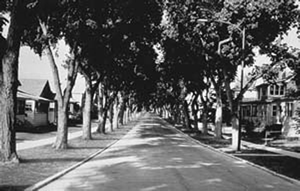 |
 |
Before and after images showing the effect of Dutch elm disease on an initially tree-lined avenue in the city of Winnipeg. From the website of the Coalition to Save the Elms. |
|
Be aware of the fungi! Read more about all this in the textbook 21st Century Guidebook to Fungi.
Updated December 7, 2016
